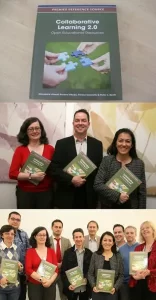Alexandra Okada, Monday 23 April 2012 |
“Collaborative Learning 2.0: Open Educational Resources,” edited by Ale Okada, Teresa Connolly, and Peter J. Scott (Open University, UK), aims to understand how OER and Web 2.0 can be deployed successfully to enrich the collaborative learning experience and ensure a positive outcome in terms of user-generated knowledge and skill development.
This book presents the current state of the art in collaborative learning through Open Educational Resources and Web 2.0. It offers the latest research through case studies, trends, and also considers future developments within the field. With a solid theoretical foundation and precise guidelines, the authors analyze the benefits that these “user-generated content, resources, and tools” promise. “Collaborative Learning 2.0: Open Educational Resources” was written by 58 authors, who are leading researchers and practitioners in their field, from 14 countries: Australia, Belgium, Brazil, Canada, Chile, Germany, Greece, India, Italy, Spain, Switzerland, The Netherlands, the UK, and the USA. The book comprises about 560 references, 168 key terms and definitions, and 25 chapters, including introductions. It is organized into four sections:
Section 1 – “Widening participation and OER Communities
Section 2 – “Producing, reusing, and recreating OER
Section 3 – “Sharing User-generated content
Section 4 – “Social Learning, Rich Media, and Games
The chapters cover a wide range of topics, including assessment, collaborative learning, communities of practice, continuous professional development, interactive contents, knowledge sharing, new media environments, OER in higher education, personal learning environments, peer support, social media, social networking, social learning, virtual laboratories, and Web 2.0. This project began in January 2010, and the process of writing, reviewing, as well as publishing this book occupied the editors and authors for almost two years. Find out more at the book’s website.
Related Links:

